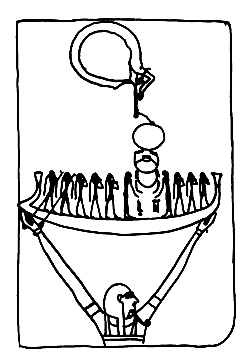
Personification of the primeval waters, the original shapeless sea of chaos. At creation, the first island or primeval hill on which the creator god Atum appeared rose out of these waters. Because they were a primeval element, Nun was regarded as one of the members of the Hermopolitan Ogdoad, with Naunet as his partner. In addition, because he was older than the creator god, he was also called the father of the gods or of Atum. The name Nun, in ancient Egyptian also 'nenu' or 'nuu', was linked by word-play with the word 'neni', which means 'be tired, inert'. This refers to the inert state of the water, just as was experienced during the inundation of the Nile. Just as the primeval hill rose out of this water, so too did the land reappear when the inundation water receded. Although the organized world was produced by the act of creation, the ancient Egyptians believed that Nun was still present. It not only surrounded the earth on all sides, but was also underneath it; the earth was perceived as floating on the waters of Nun. The primeval water welled up through holes in the earth. When the foundations of a temple were being dug, for example, the Egyptians dug down to the water table so that the temple was literally rising up out of the primeval waters. The Nile, which in the Egyptian view sprang forth from two holes in the earth, also consisted of primeval water. Rain, too, apart from being connected with the god Seth, was also regarded as the waters of Nun because the Egyptians perceived it as coming from a Nile in the sky. Nun was depicted as a man, sometimes with a double plume on his head, and sometimes lifting up the bark of the sun god Re. Occasionally, when he forms part of the Ogdoad, he is shown with the head of a frog and a man's body.